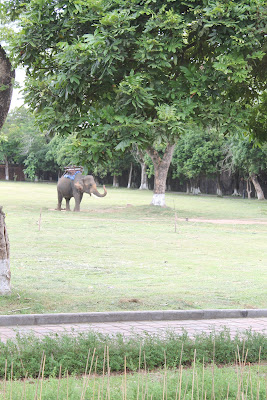As I briefly mentioned, Hue's main draw is that it was the capital of Vietnam until 1945, the seat of the Nguyen emperors. The emperors ruled from
the Citadel, which is a large (2 km x 2 km) walled area on the banks of the
Perfume River, surrounded by a moat and containing the Imperial City and the Forbidden City, where all of the royal family and concubines hung out.
 |
| Cyclos and motorbikes heading over the moat on one of the bridges into the Citadel. |
 |
| 2 meters thick wall surrounding the Citadel. |
 |
| On the ground of the citadel are some of the war relics from the 1975 battle when Hue fell to the North Vietnamese Army... tanks, guns, etc. |
 |
| Another view of the moat and the massive walls surrounding the Citadel. |
 |
| Tim standing with several of the Nine Holy Cannons, which are symbolic protectors of the Imperial Palace, commissioned by Emperor Gia Long. 4 of the brass cannons represent the 4 seasons and the other 5 represent the 5 elements (just like how each of the 5 Marble Mountains represented an element). |
 |
| I don't know if you can read this description, but it says that the Nine Holy Cannons were called "The Most Powerful Unbeatable Senior Lieutenant General." Hell yeah. |
 |
| A close-up of one of the gates to the Citadel. |
 |
| Ngo Mon Gate, the principle entrance to the Imperial City. It was used for ceremonies and "troop viewing" by the Emperors. |
 |
| This is where the Nguyen Dynasty ended when Emperor Bao Dai abdicated to a Ho Chi Minh delegation in 1945. It's also the site of Tim wearing a sweaty t-shirt in 2012. |
 |
| A painting depicting said "troop viewing" - troops and subjects all lined up below the gate. |
There are still some elephants kicking around the Imperial City, giving rides. And golden dragon statues, not giving rides.
 |
| A large courtyard behind the palaces. Many of the buildings that used to be here were destroyed in various bombing campaigns by the French and Americans. |
 |
| Emperor Bao Dai's Imperial Tennis Court. Labeled as a "special relic" on the sign, it has been lovingly restored by someone who really likes to play tennis. |
The elaborate entrance gates of the Truong San residence... really beautiful, super-detailed mosaics of dragons and phoenixes made from broken pottery.
The Mieu Temple Complex includes the 3-tired
Hien Lam Pavilion and several temples housing shrines to each of the emperors:
The pavilion is surrounded by
Nine Dynastic Urns, each dedicated to one of the Nguyen emperors. They are pretty massive (to symbolize the power and stability of the Nguyen dynasty) but really delicately detailed:
Me, standing in another cool gateway, trying not to pass out from heat exhaustion:
Tim, admiring the detail work. So many dragons...





























No comments:
Post a Comment
Note: Only a member of this blog may post a comment.